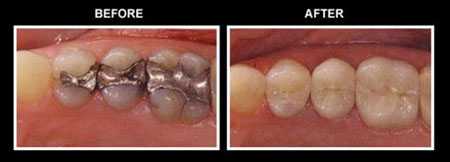Unveiling the Distinctions: Amalgam Fillings vs. Composite Fillings
In the realm of dental restorations, patients are presented with a choice between two popular options: amalgam fillings and composite fillings. Both materials have their merits, but in this article, we will delve into the unique characteristics of each and highlight why composite fillings often emerge as the preferred choice for many patients. Let's explore the key differences between these two types of dental fillings.
- Composition: Amalgam Fillings: Amalgam fillings, also known as silver fillings, are made by combining mercury with a mixture of other metals such as silver, tin, and copper. The resulting material is a durable and highly resistant filling.
Composite Fillings: Composite fillings, on the other hand, are crafted from a blend of tooth-colored resin materials, including glass or ceramic particles. This mixture is not only aesthetically pleasing but also provides excellent bonding capabilities.
- Appearance: Amalgam Fillings: While effective in restoring dental health, amalgam fillings have a noticeable silver-gray appearance. This can be a concern for patients seeking a more natural-looking smile, especially when the restoration is required on a visible teeth.
Composite Fillings: One of the standout advantages of composite fillings is their ability to mimic the natural color of teeth. With a wide range of shades available, composite fillings seamlessly blend with the surrounding tooth structure, providing an aesthetically pleasing result.
- Durability: Amalgam Fillings: Amalgam fillings are renowned for their strength and durability. They can withstand significant biting forces and are less prone to wear and tear over time. However, the metal composition can expand and contract with temperature changes, potentially leading to cracks or fractures in the tooth structure.
Composite Fillings: Although composite fillings may not match the same level of durability as amalgam fillings, advancements in material technology have significantly improved their strength and longevity. When properly cared for and maintained, composite fillings can endure normal chewing forces and can be an excellent long-term solution.
- Versatility: Amalgam Fillings: Due to their exceptional strength, amalgam fillings are typically recommended for restoring large cavities in molars or areas subjected to heavy chewing forces. They are less technique-sensitive and can be placed in a relatively short amount of time.
Composite Fillings: Composite fillings offer greater versatility in terms of their application. They can be used for both front and back teeth, as well as smaller restorations. Composite materials allow for precise shaping and contouring, making them an excellent choice for achieving natural-looking results.
- Preservation of Tooth Structure: Amalgam Fillings: One drawback of amalgam fillings is that they require more extensive removal of healthy tooth structure to create space for placement. This can compromise the overall integrity of the tooth.
Composite Fillings: Composite fillings are known for their conservative nature, as they require minimal removal of healthy tooth structure. Dentists can preserve more of the natural tooth, promoting its long-term health and strength.
While both amalgam and composite fillings have their merits, composite fillings emerge as a superior choice for many patients due to their natural appearance, improved bonding capabilities, versatility, and conservative approach to tooth preservation. However, the ultimate decision should be made in consultation with a trusted dentist who can evaluate your unique dental needs and recommend the most suitable option for your situation.
Remember, maintaining regular dental check-ups and practicing good oral hygiene are essential for the longevity of any dental restoration. By working closely with your dentist, you can make informed decisions about the best filling material to restore and enhance your dental health. -Berkay Öksüz Patient Coordinator


Yorumlar
Yorum Gönder